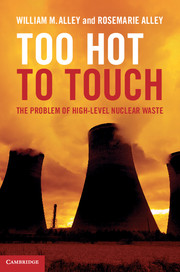Book contents
- Frontmatter
- Contents
- Acknowledgments
- List of units
- List of abbreviations
- Introduction
- Part I The problem
- 1 The awakening
- 2 Brainstorming
- 3 The ocean as a dumping ground
- 4 Radioactivity and atomic energy
- 5 The Cold War legacy
- 6 The peaceful atom and its wastes
- 7 Recycling
- 8 Dry cask storage
- 9 Interim storage
- 10 A can of worms
- 11 WIPP
- Part II The mountain
- Part III No solution in sight
- Appendix Discussion questions
- References
- Index
11 - WIPP
from Part I - The problem
Published online by Cambridge University Press: 05 February 2013
- Frontmatter
- Contents
- Acknowledgments
- List of units
- List of abbreviations
- Introduction
- Part I The problem
- 1 The awakening
- 2 Brainstorming
- 3 The ocean as a dumping ground
- 4 Radioactivity and atomic energy
- 5 The Cold War legacy
- 6 The peaceful atom and its wastes
- 7 Recycling
- 8 Dry cask storage
- 9 Interim storage
- 10 A can of worms
- 11 WIPP
- Part II The mountain
- Part III No solution in sight
- Appendix Discussion questions
- References
- Index
Summary
You cannot say, or guess, for you know only
A heap of broken images, where the sun beats . . .
I will show you fear in a handful of dust.
T.S. Eliot, The Waste LandTen thousand years into the future, on the baking windswept sands of what is today southeastern New Mexico, a huge earthen berm bears witness to a previous civilization. Twice as old as the Egyptian pyramids now are, the berm is an eroded fortress over a half-mile long and nearly as wide. The 100-foot (30 m) -wide base slopes upward, in places almost four storeys tall. Excavation into the berm uncovers small markers of granite, aluminum oxide, and fired clay, carved with hieroglyphs in seven dead languages. The berm also bristles with magnets and radar reflectors that transmit unique “signatures.”
Flanking the berm’s insidewalls there once stood huge stone pillars weighing over 100 tons each, now mostly toppled and broken. The same hieroglyphs cover the pillars’ surfaces. Carved among the ancient words are human faces – unquestionably expressing terror or horror, or both.
In the center of the fortress there still stands part of a small granite enclosure, open to the blazing sky. The crumblingwalls, once almost half the height of the berm, are covered with the same messages, the same terrorized human faces.
- Type
- Chapter
- Information
- Too Hot to TouchThe Problem of High-Level Nuclear Waste, pp. 152 - 170Publisher: Cambridge University PressPrint publication year: 2012



